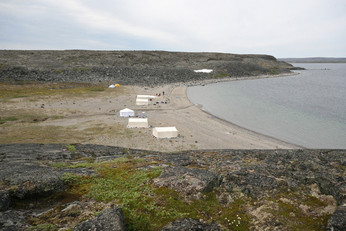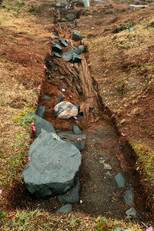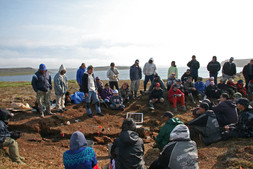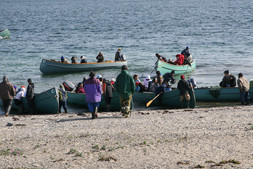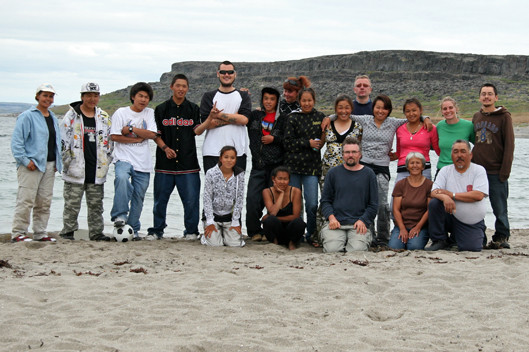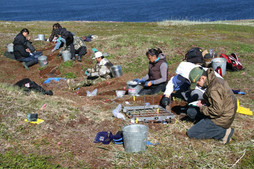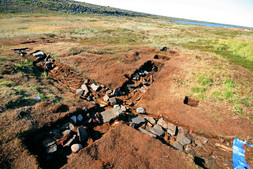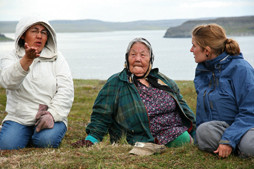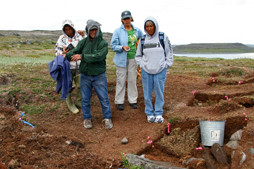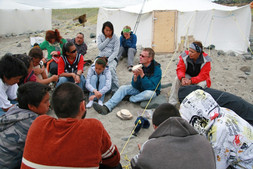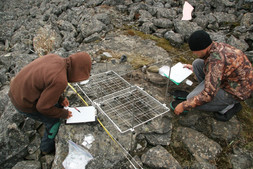- About
- Discovering Archaeology
- Projects and Activities
- Online Resources
- References
Archaeology
International Polar Year (IPY)
2007-2008The Study of Thule Settlement Patterns and Seasonal Procurement Strategies in Coastal Nunavik.
As an active participant in the International Polar Year (IPY), Avataq’s archaeology department has worked on a variety of related research projects.
Research context
Thule/Inuit sites in Nunavik: a model of territorial occupation
The study of Thule/Inuit archaeology in Nunavik requires further research. One interesting known fact about early winter Thule/Inuit sites is that they are almost exclusively located on islands; we know of very few semi-subterranean dwellings on the mainland. Also, the spring/summer/early fall counterparts appear to be located on both the mainland and the islands. This seems to indicate a dual subsistence strategy closely related to the seasons. Within the framework of current knowledge, it would be interesting to document this settlement pattern, which seems to emerge from the available data. It is necessary to determine whether the pattern evolved over time and if so, what might have triggered such changes. This study will be especially relevant in efforts to further our understanding of climate change and social dynamics.
Strategies for the procurement and transformation of raw materials
Technology will also be a relevant theme for the project, since we know next to nothing about Nunavik Thule/Inuit strategies for procuring and transforming raw materials. The use of bones as a raw material is also a topic of interest for the project. Raw material procurement strategies are certainly linked to social dynamics, but we do not know precisely how these strategies affected social dynamics. Climate change could have had an impact on these strategies by making access to primary resources more difficult and forcing groups to focus their energies on alternatives.
Research activities
During the summers of 2007 and 2008, teams of approximately 20 people participated in the excavation of archaeological site IbGk-3 and in the creation of an initial inventory of artifacts found in this region of Nunavik. Site IbGk-3 is located on Itingualuk (Drayton Island), on the eastern coast of Hudson Bay, near the community of Inukjuak. This research was carried out in conjunction with our participation in the International Polar Year (IPY). This project was initiated by Daniel Gendron and directed by Pierre M. Desrosiers.
Summer 2007 activities
Participants
In addition to Pierre M. Desrosiers, the team was comprised of Tommy Weetaluktuk, Sackariassie Pauloosie (hunter-guide), Allie Nalukturuk (hunter-guide), Annie Kokiapik (cook), Mae Partridge (cook), and assistant hunter-guides Paulusie Inukpuk and Chris Amgiyou. Two students from Europe also participated: Claire Houmard (doctoral student, Université Paris 10, France) and Enrico Foietta (undergraduate student, Italy). Nine Inuit students did a four-week apprenticeship in excavation methods including surveying, technical drawing, using grids and artifact recovery. The students were Natalie Echalook, Abraham Kasudluak Mina, Abilie Williams, Magan Kasudluak, Stephan Mina, Tommy Niviaxie, Allie Aculiak, Moses Idlout and Susie Mina. Some of these students also received additional training in geography from a team of geomorphologists from Université Laval who accompanied our research team. The Laval group was led by Najat Bhiry and included Anne-Marie Lemieux, Elsa Censig and Bryan Sinkunas.
Site IbGk-3: semi-subterranean Inuit dwellings
Our excavations allowed us to establish a number of facts about the IbGk-3 site. It appears that the site was occupied by Palaeoeskimos, and possibly founded over 2,500 years ago. Nearly 2,000 years later, the site was re-occupied by Inuit who built qarmait with tunnel entrances. Only a small portion of the site has been excavated thus far, but the work has already produced some significant findings. We discovered that wood, a very rare material in the eastern Arctic, had been used to build the dwellings’ roof frameworks. These discoveries will lead to a better understanding of the ancient construction methods behind these houses.
Regional inventory of sites, structures, and quarries
In addition, our brief archaeological survey led to the identification of more than 40 new sites, mostly on Itingualuk (Drayton Island) but also on Innalikallak (Harrison Island) and Napaartulik (Patterson Island). This demonstrates the area’s rich archaeological heritage, especially on the islands. The sites we discovered included many summer dwellings and secondary structures such as fox traps, caches and graves, and included numerous Palaeoeskimo sites. A number of siltstone quarries were also explored.
Summer 2008 activities
Participants
In summer 2008, the Avataq Cultural Institute continued archaeological research on the Innaliit (the Hopewell Islands), near the community of Inukjuak. The team was led by Pierre M. Desrosiers, assisted by Elsa Cencig, and composed of Nally Weetaluktuk and Andrew Epoo, both of whom are Avataq staff members. Local participants included Simeonie, Alicie and Andy Nalukturuk; Joanie Elijassiapik; and Allie Nalukturuk. The field school included 14 secondary school students: Allie Aculiak, Bobby Angnatuk, Moses Idlout, Natalie Echalook, Monica Echalook, Bobby Elijassiapik, Alec Epoo, Pamela Inukpuk, Sarah Iqalluk, Matiusi Kasudluak, Megan Kasudluak, Tonya Moreau, Eva Nowra and Paulo Palliser. Anne-Marie Lemieux (Université Laval student) compared geomorphological and archaeological data to study the evolution of housing in the region. She also conducted many interviews with local elders to complete her research. Geomorphologist Najat Bhiry (Université Laval) and wood species and dendrochronology specialist Dominique Marguerie (Université de Rennes) also participated.
Introductory training for Inukjuak students
Local students were given a one-day introduction to archaeology at the Inukjuak school. Out in the field, they were able to observe an archaeological dig underway, and were taught some of the basics of Quaternary geology and dendrochronology. Gathered around an evening campfire, Simeonie Nalukturuk told the students about the region’s history and traditional legends. They also participated in a guided tour, led by McGill geologists, to the outcrop that contain the oldest known rocks on Earth.
Excavation of a semi-subterranean winter dwelling
Most work centred on site IbGk-3. This camp was first used by Palaeoeskimos who erected structures that were only slightly below grade. Later, Inuit dug out semi-subterranean dwellings on the same site in order to establish a winter camp. Structure 1 (an Inuit semi-subterranean winter dwelling) was the primary structure researched. Our work allowed us to further expose the dwelling’s roof structure, which is composed of wood and sod. In some of the excavation units, we were able to extract all the wood, allowing access to the dwelling’s internal layout (i.e. the living area). Given the significant time required to excavate the wooden artifacts, we decided to devote some of our efforts to the space around the front of the structure, an area used as a midden. This refuse pile revealed information about the activities and daily life of the dwelling’s occupants. It contains mainly bone material and trimmings.
We had several visitors to our excavation site, including two elders (Lucy Weetaluktuk and Adamie Niviaxie) who spent a day on-site answering our questions. In order to better understand the procurement strategies for wood and assess the age of our excavated samples, driftwood was collected from different islands in order to establish its provenance and age. These samples will eventually serve as comparative material for future research.
Related CURA S.I.A. work undertaken in summer 2008
Documentation of site IcGn-8
Alongside our work on site IbGk-3, we also initiated documentation efforts on the IcGn-8 quarry site in collaboration with Adrian Burke (Université de Montréal), who joined us for 10 days. The work included mapping of this huge site where the siltstone outcrop is more than 700 metres long. Concentrations of waste flake (by-product of stone tool making), some likely a metre deep, were found in several areas around the outcrop. The equivalent of two square metres, divided among three test holes, was excavated on the site in 2008. The work resulted in the collection of over 60,000 artifacts, mainly waste flake. Evidence of over 200 stone hammers was documented in situ. These hammers were used to spall large slabs of rock to obtain pieces that could be shaped into tools.
Inventory of regional archaeological sites
In addition to the work described above, we visited different islands in order to inventory their archaeological sites. This led to our discovery of previously unknown sites and allowed us to catalogue hundreds of archaeological structures. Raw stone material sources were also identified and sampled, but no new quarries were found. In this resource-rich area, islands were densely inhabited. Many years of active research will be required to more accurately document the 4,000-year history of human presence in the region.
Contact: Daniel Gendron, Pierre M. Desrosiers
For more information :
Dynamic Inuit Societies in Arctic History : http://ipy.utoronto.ca/
Nunatsiaq News : http://www.nunatsiaqonline.ca/archives/2007/710/71012/news/nunavik/71012_592.html
Documents en ligne au sujet de ces recherches
Research Report
IPY Archaeological Project, Inukjuak Fieldwork 2008. AR259
Avataq Cultural Institute
2009

